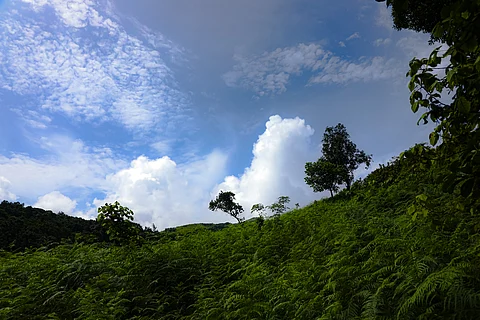
- Destinations
- Experiences
- Stay
- What's new
- Celebrating People
- Responsible Tourism
- CampaignsCampaigns
- SubscribeSubscribe
- Buy Now

Devarakadus, also known as sacred groves, are forest patches traditionally protected by local communities in Karnataka due to their spiritual, cultural, and ecological significance. Particularly prevalent in Kodagu (Coorg), they are regarded as the abodes of deities and are treated as sacred spaces, where activities like tree felling or clearing are prohibited.
The concept of Devarakadu in Karnataka is rooted in the ancient understanding of the interconnectedness between nature and spirituality. Sacred groves are a part of many agrarian cultures around the world, including those in South America, Africa, Australia, Europe, and most Asian countries.
Devarakadus originated in Karnataka as a traditional practice of designating forest areas as sacred spaces dedicated to deities. These ancient groves often contain a temple or shrine and are believed to be the dwelling places of local deities. The community protects them, ensuring the long-term conservation of the forest ecosystem.
Devarakadus are forest patches traditionally protected by local communities in Karnataka due to their spiritual, cultural, and ecological significance. These groves are dedicated to local deities, with shrines often located within them. Particularly prevalent in Kodagu (Coorg), they are regarded as the abodes of deities and are treated as sacred spaces, where activities like tree felling or clearing are prohibited.
Devarakadus play a vital role in maintaining biodiversity, serving as havens for various plant and animal species. They harbor a rich diversity of flora and fauna and act as important ecological niches. Local communities are crucial in safeguarding these groves, often managing them as common property resources.
They contribute to maintaining water sources, regulating microclimates, and providing habitats for numerous species. Devarakadus are deeply embedded in the cultural and social fabric of the communities that protect them, frequently playing significant roles in rituals and festivals.
Kodagu is renowned for its high density of sacred groves, with approximately one grove for every 300 hectares, potentially making it one of the highest densities in the world. A unique feature of Kodagu is that while the Forest Department owns and manages these groves as protected forests, local communities are responsible for their care and management. Around 120 deities are worshipped, with unique forms of worship practiced by 18 local communities, demonstrating a strong sense of communal unity.
In Kodagu, every village is likely to have at least one Devarakadu. The size of these sacred groves can vary significantly, ranging from less than one acre to over 25 acres. Although they are owned by the Forest Department and designated as Protected Forests, these areas are managed by local communities as common property resources. Each Devarakadu is named after a specific deity and serves as a place of worship.
In Karnataka, one notable grove is Ainmane Devarakadu, known for its unique rituals and rich biodiversity. Another significant site is Paadi Igguthappa Devarakadu, which is dedicated to the deity Igguthappa and holds great cultural and religious importance. Poomale Devarakadu is renowned for its dense forest cover and sacred significance. Lastly, Eeroli Bana, a grove dedicated to Lord Aiyappa at Thaaka village of Cherambane, spans over 800 acres and is highly revered by the local villagers.
The Devarakadu Tamarind Grove, also known as Nallur Tamarind Grove, is a biodiversity heritage site located in Devanahalli, near Bengaluru. It is renowned for its ancient tamarind trees, some of which are over 400 years old. The grove is considered a relic of the Chola dynasty and serves as a testament to the area's rich biodiversity.
A festival dedicated to celebrating the sacred groves takes place every year. Known as 'Devara Kadu Habba' or the Sacred Grove Festival, these occur primarily between April and July. Some villages celebrate it annually, while others do so biannually. This festival plays a crucial role in the preservation of the sacred groves.
These sacred groves, despite their significance, are facing threats from encroachment, changing religious beliefs, and altered perceptions. To address this issue, various organisations and government agencies are working to protect and promote the conservation of these sacred spaces.
The Supreme Court has directed the forest department to classify sacred groves as 'forests' and notify them as 'community reserves' under the Wildlife Protection Act. Additionally, scientific inventories of the flora and fauna, along with documentation of the history, beliefs, and myths associated with the groves, are being conducted to support their conservation.
